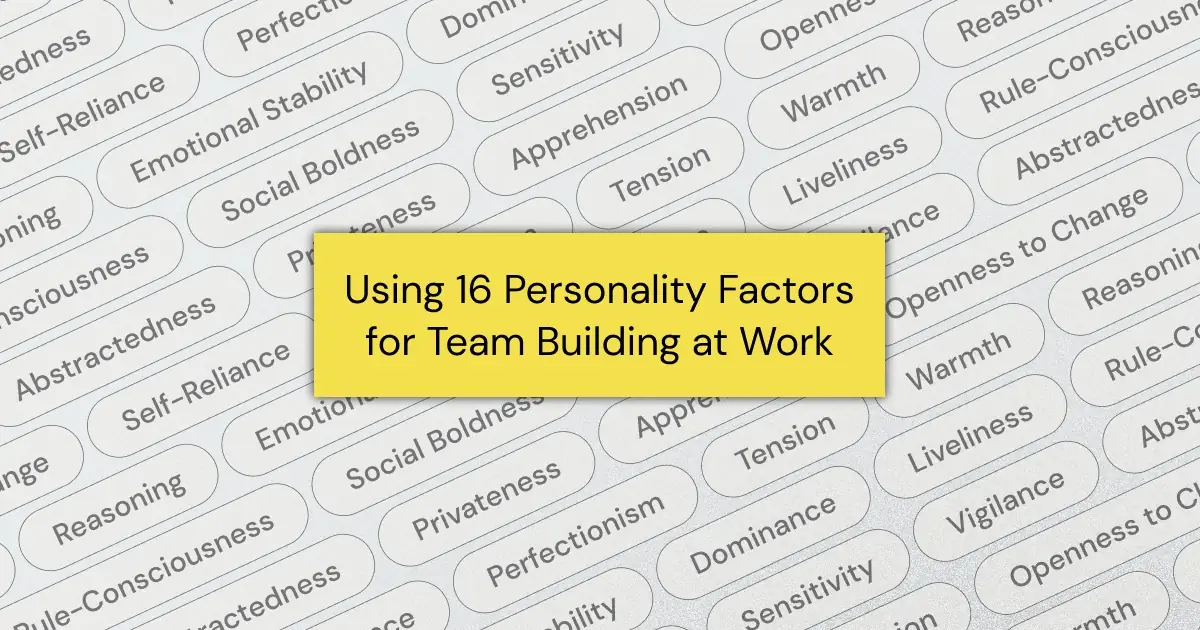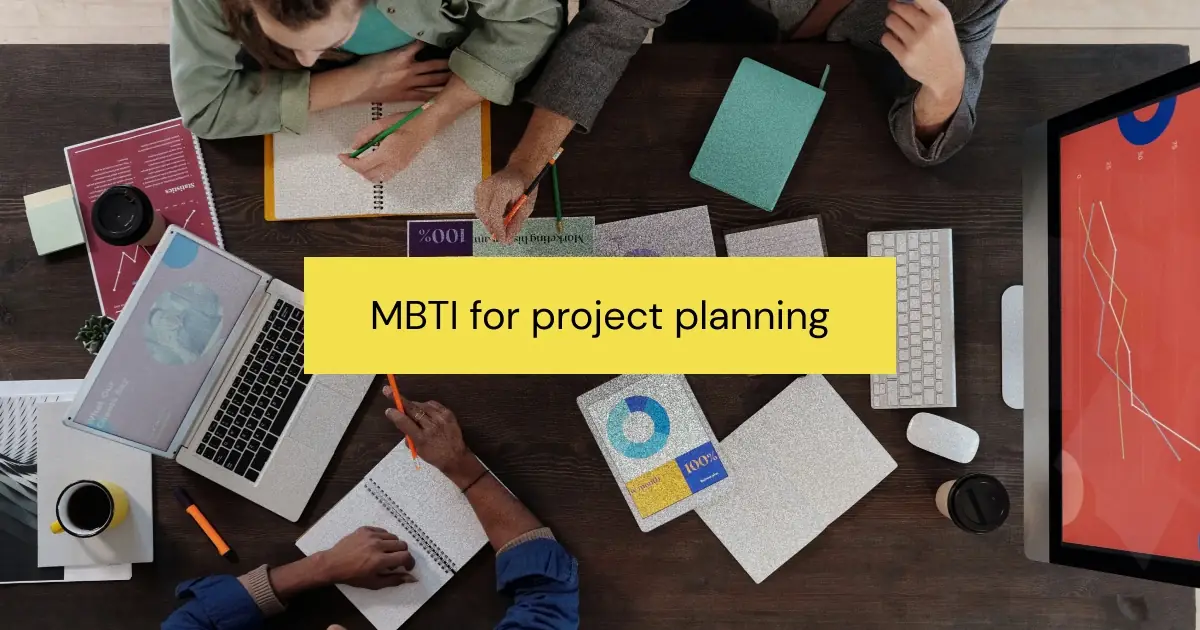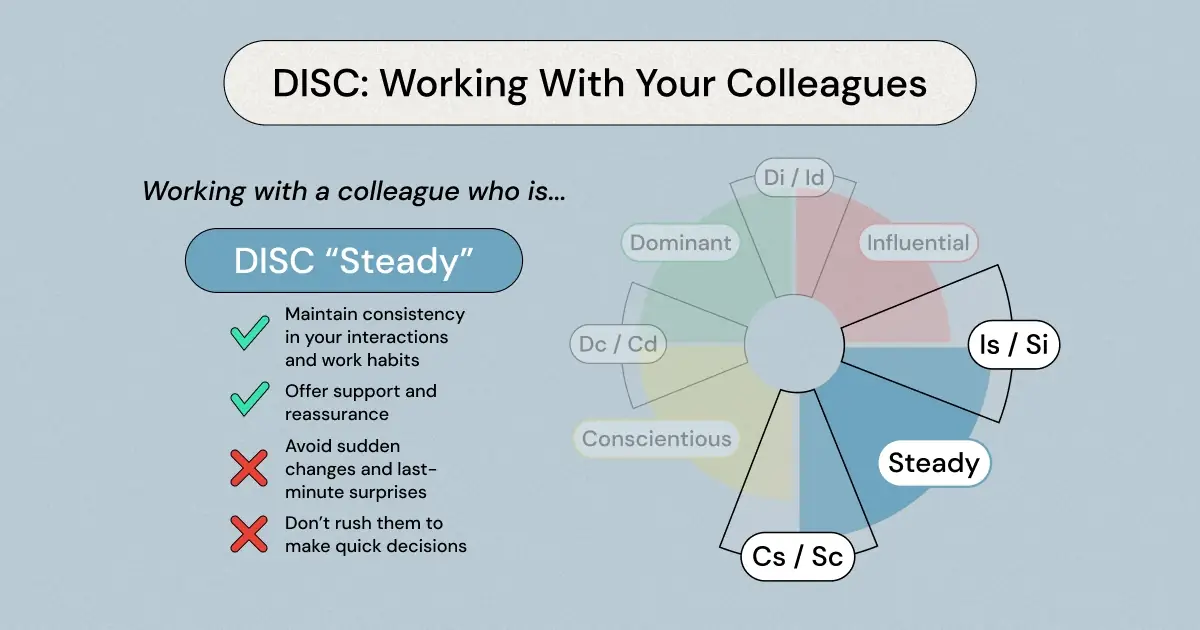In the heart of every thriving tech startup, bustling marketing team, or dynamic consulting group lies a mosaic of unique personalities. Understanding these personalities isn't just about putting labels on people; it's about unlocking the full potential of your team. Enter the Big Five personality traits (sometimes also called the OCEAN personality test): Openness, Conscientiousness, Extraversion, Agreeableness, and Neuroticism. These aren't just fancy terms borrowed from psychology textbooks—they are the keys to enhancing collaboration, creativity, and productivity in any professional setting.
Why does this matter in the workplace? Imagine a team where every member's strengths are leveraged, and weaknesses are supported—a team that communicates flawlessly, meets deadlines with ease, and tackles challenges with a collective resilience. This isn't a pipe dream; it's entirely achievable with the insight provided by the Big Five personality test.
Our goal with this post is straightforward: to guide you, the innovative leader, the forward-thinking manager, or the team player, on a journey to understand and apply the Big Five personality test in your work environment. Whether you're aiming to refine team dynamics, assign roles more effectively, or simply foster a more supportive and understanding workplace culture, you're in the right place.
Wondering what the best Big Five alternatives are? Check out our round-up of the top 5 Big Five alternatives.
So, let's dive in and explore how the Big Five personality traits can transform the way your team works together, propelling your projects to new heights and your team to unprecedented success.
Decoding the Big Five Personality Traits for Team Success: OCEAN Personality Traits Explained
At the core of every successful team lies a deep understanding of its members' personalities. The Big Five personality traits provide a scientific framework to decode these personalities, paving the way for improved teamwork, communication, and productivity. Let’s break down each trait and explore how it can be a game-changer in professional settings.
Openness: The Innovators and Visionaries
Individuals high in Openness are your team's creative powerhouses and outside-the-box thinkers. They thrive on innovation and are always on the lookout for new ways to solve problems. In a tech startup, they're the ones suggesting bold, new product features. In a marketing team, they're crafting compelling, original campaigns. Embracing openness leads to a culture where ideas flow freely, fostering innovation and keeping your team ahead of the curve.
Conscientiousness: The Organizers and Executors
Conscientiousness is the trait of reliability and discipline. Team members who score high here are your planners and doers. They set the pace for meeting deadlines and maintaining high-quality standards. Think of the project manager who outlines every step of a campaign, or the developer who methodically tackles coding tasks. Cultivating conscientiousness within your team means projects are completed efficiently and to the highest standard.
Extraversion: The Communicators and Energizers
Extraversion shines through in those who are sociable, outgoing, and energetic. These team members excel in communication, making them invaluable in client meetings or team huddles. In a consulting team, they're building rapport with clients. Among developers, they're facilitating lively stand-ups. Extraverts inject energy into the team, boost morale, and ensure that collaboration is not just productive but also enjoyable.
Agreeableness: The Mediators and Team Players
Agreeableness marks the compassionate and cooperative members of your team. They are the glue that holds the team together during challenging times, ensuring conflicts are resolved amicably and everyone feels valued. In a high-stakes project, they're the ones ensuring smooth team interactions and fostering an environment where support and cooperation are paramount.
Neuroticism: The Realists and Support Seekers
Finally, Neuroticism, often misunderstood, relates to emotional sensitivity. While high levels can indicate vulnerability to stress, understanding this trait can be powerful. It reminds us of the importance of creating a supportive work environment where stress management techniques are shared, and mental well-being is prioritized. Recognizing and supporting those who may have higher levels of neuroticism can lead to a more resilient and empathetic team.
Leveraging Personality for Team Excellence
Understanding the Big Five isn't about boxing people into categories—it's about leveraging these insights to build a balanced, high-performing team. By recognizing and valuing the diverse personalities in your team, you create a workspace where innovation thrives, deadlines are met with confidence, and every team member feels valued and understood.
{{inline-cta}}
Evaluating the Big Five: Pros and Cons for Team Building
The Big Five personality traits offer a robust framework for understanding individual differences and leveraging these insights for team building. However, like any tool, its application in the workplace comes with its own set of advantages and challenges. Let's delve into the pros and cons of using the Big Five for team building.
Pros of Using the Big Five for Team Building
- Enhanced Self-awareness and Mutual Understanding: The Big Five can significantly increase self-awareness among team members, helping individuals understand their work preferences, strengths, and areas for improvement. This mutual understanding fosters respect and empathy, crucial for effective collaboration.
- Strategic Team Composition: By understanding the personality traits of team members, leaders can strategically compose teams that balance strengths and weaknesses. This can lead to more efficient problem-solving, creativity, and overall team performance.
- Improved Communication: Insights from the Big Five can tailor communication strategies to match the preferences of different personality types, reducing conflicts and misunderstandings and enhancing team cohesion.
- Targeted Personal Development: The Big Five can identify areas for personal growth, allowing for more focused and effective professional development efforts. This not only benefits the individual but also enhances the team's capabilities.
Cons of Using the Big Five for Team Building
- Risk of Oversimplification: There's a danger in reducing complex individuals to their Big Five scores. Personality traits are just one aspect of a person, and overreliance on these measures can lead to oversimplification and stereotyping.
- Potential for Labeling and Bias: If not handled carefully, personality assessments can lead to labeling, where individuals feel pigeonholed by their results. This can also introduce biases in how team members are perceived and treated, affecting team dynamics and individual opportunities for growth and leadership.
- Privacy Concerns: The process of administering personality tests and sharing results must be managed with sensitivity to privacy concerns. Team members may feel uncomfortable sharing personal information or fear that it could be used against them.
- Dynamic Nature of Personalities: Personalities can evolve over time, and the Big Five scores might not capture these changes. Relying on outdated information can lead to misalignments in team building and development strategies.
Balancing the Scales: A Thoughtful Approach to the Big Five
While the Big 5 personality types provide valuable insights for team building, it's essential to approach their use thoughtfully and ethically. This means:
- Ensuring voluntary participation and confidentiality in personality assessments.
- Using the Big Five as one of several tools for understanding team dynamics, not the sole basis for decisions.
- Providing training on interpreting and applying personality insights to prevent oversimplification and bias.
- Encouraging an ongoing dialogue about personal and team development, recognizing that personalities and team needs evolve.
Conclusion: The Big Five as a Compass, Not a Map
The Big 5 personality traits offer a powerful compass for navigating the complex terrain of team building. When used wisely, they can enhance understanding, communication, and performance within teams. However, it's crucial to remember that these insights are guides, not definitive maps. The most successful teams are those use the Big 5 personality test to respect individual differences, adapt to changing dynamics, and commit to continuous growth and learning.
By weighing the pros and cons, organizations can leverage the Big Five in a way that respects individuality while fostering a cohesive, dynamic, and high-performing team environment.
Implementing the Big Five Personality Test for Team Excellence
Integrating the Big Five personality test into your team's dynamics isn't just a strategic move—it's a transformative one. Here’s a step-by-step guide to seamlessly incorporate these insights into your workplace, ensuring your team not only thrives but excels.
Step 1: Selecting and Administering the Right Test
The first step to unlocking the potential of your team is choosing a reputable Big Five personality test. Look for tests backed by scientific research to ensure accuracy and reliability. Note also that there are many free Big 5 options. Once selected, organize a team session to explain the purpose and benefits of the test, emphasizing its role in enhancing team dynamics and individual job satisfaction. Encouraging participation in a supportive, non-judgmental environment is key to getting genuine responses from team members.
Step 2: Analyzing and Sharing Results Constructively
After your team has completed the test, it's time to dive into the results. Consider bringing in a professional psychologist or a certified coach to provide expert analysis and facilitate a workshop where results can be discussed openly and constructively. This step is crucial for ensuring that the information is used positively, fostering an atmosphere of growth and understanding rather than judgment.
Step 3: Applying Insights to Optimize Team Roles and Projects
With a clear understanding of each team member's personality traits, you can begin to strategically align roles and tasks with individual strengths. For instance, leverage the creativity of those high in Openness by assigning them to innovation-driven projects, or place individuals high in Conscientiousness in roles where detail orientation is critical. This strategic alignment not only maximizes productivity but also enhances job satisfaction by allowing individuals to work in ways that naturally suit them.
Step 4: Continuous Learning and Adaptation
The final step is to view the implementation of the Big Five personality test as a continuous journey rather than a one-time event. Regularly revisiting the test results and incorporating them into team reviews and personal development plans can help your team adapt to changes and address any emerging challenges. Encourage ongoing dialogue about personality traits and how they influence work styles, fostering an environment where personal growth and team development go hand in hand.
Using The Big Five Teamwork Model for Effective Team Building
In the quest to build high-performing teams, understanding the Big Five personality traits is just the beginning. The Big Five Teamwork Model takes this knowledge a step further, offering a blueprint for leveraging these traits to achieve exceptional teamwork. This model emphasizes the importance of diversity, balance, and adaptability in team settings, guiding teams on how to harness the strengths of each personality trait for collective success.
The Foundation of Effective Teamwork
The Big Five Teamwork Model is built on the premise that a team’s strength lies in its diversity and is key to employing the Big Five personality traits in the workplace. Each personality trait brings unique strengths to the table:
- Openness contributes innovative ideas and creative solutions.
- Conscientiousness ensures reliability and attention to detail.
- Extraversion fosters effective communication and energizes the team.
- Agreeableness enhances cooperation and conflict resolution.
- Neuroticism, when understood and managed, can lead to greater emotional intelligence and resilience.
By recognizing and valuing these diverse contributions, teams can create a more dynamic, flexible, and robust approach to achieving their goals.
Building Balanced Teams
The key to the Big Five Teamwork Model is balance. It’s about aligning team members in a way that their strengths complement each other while mitigating potential weaknesses. For instance, pairing individuals high in Openness with those high in Conscientiousness can lead to both innovative and practical solutions. Similarly, those high in Agreeableness can help mediate and balance the ambitions of more extraverted team members, ensuring that all voices are heard and valued.
Strategies for Implementation
To effectively implement the Big Five Teamwork Model, teams should:
- Assess and Share: Begin with a comprehensive assessment of team members' Big Five traits. Share results openly to build understanding and appreciation of each other’s strengths.
- Strategic Alignment: Align team roles and tasks based on personality strengths. Ensure that for every project or challenge, the team composition is strategically thought out to leverage complementary traits.
- Foster Flexibility: Encourage team members to step outside their comfort zones and develop skills in areas that are not their natural strengths. This not only aids personal growth but also contributes to the team’s versatility.
- Continuous Learning: Make the Big Five Teamwork Model part of your team’s continuous learning culture. Regularly review team performance and dynamics, and be open to adjusting roles and strategies as needed.
Navigating Challenges with Insight
The model also provides a framework for navigating team challenges with insight and empathy. Understanding the underlying personality traits can help de-escalate conflicts, manage stress, and adapt to changing circumstances with agility.
Conclusion: Unleashing the Power of Personality in Teams
The Big Five Teamwork Model offers a powerful approach to building and sustaining high-performing teams. By understanding and strategically leveraging the diverse personality traits of team members, leaders can create an environment where innovation, productivity, and job satisfaction thrive.
As we integrate this model into our workplaces, we not only enhance our team's effectiveness but also contribute to a more inclusive, dynamic, and fulfilling work culture. The journey towards exceptional teamwork begins with embracing the unique strengths that each personality brings to the table, guided by the insights of the Big Five.
The Impact of the Big Five Personality Traits on Authentic Leadership
In the evolving landscape of modern workplaces, the concept of authentic leadership has gained prominence. Authentic leaders are those who are self-aware, maintain a strong moral compass, and are transparent and consistent in their interactions. Understanding the Big Five personality traits provides a solid foundation for developing authentic leadership qualities, as these traits significantly influence how leaders relate to themselves and their teams.
The Role of the Big 5 Leadership Traits in Shaping Authentic Leaders
- Openness: Leaders high in openness are characterized by their willingness to embrace new ideas, innovate, and adapt to change. This trait fosters a culture of continuous learning and encourages open communication, making leaders more approachable and relatable to their teams.
- Conscientiousness: This trait is crucial for leaders to demonstrate reliability, organization, and a strong work ethic. Conscientious leaders are seen as dependable and trustworthy, which is foundational for building respect and integrity within teams.
- Extraversion: Extraverted leaders are often effective communicators who can inspire and motivate their teams. Their energy and enthusiasm can drive team engagement and foster a positive work environment, essential components of authentic leadership.
- Agreeableness: Leaders who score high in agreeableness are typically compassionate, cooperative, and good at managing conflicts. This trait helps in building strong, trusting relationships with team members, crucial for authentic leadership.
- Neuroticism: While often viewed negatively, understanding and managing one’s own neurotic tendencies can enhance a leader's emotional intelligence. Leaders who can navigate their own emotional landscapes can better support their team’s well-being and create a more empathetic and understanding work culture.
Cultivating Authentic Leadership through the Big Five
To cultivate authentic leadership qualities, professionals can focus on the following strategies:
- Self-awareness and Development: Use the insights from the Big Five personality test to gain a deeper understanding of your leadership style, strengths, and areas for growth. Embrace continuous self-improvement and seek feedback to develop your authentic leadership qualities.
- Balanced Leadership Approach: Strive for a balanced approach by leveraging your strengths and working on your weaker areas. For example, if you're naturally less extraverted, consciously work on communication skills to ensure your team feels heard and supported.
- Fostering Transparency and Trust: Be open about your personality traits and how they influence your leadership style. This transparency can foster trust and encourage a culture where everyone feels valued for their unique contributions.
- Ethical Decision-Making: Use your understanding of conscientiousness and agreeableness to guide ethical and moral decision-making. Authentic leaders are known for their integrity and for making decisions that align with the team and organization's values.
- Emotional Resilience: Work on emotional resilience, particularly if you have higher levels of neuroticism. Developing strategies to manage stress and emotional challenges not only benefits you but also sets a positive example for your team.
Conclusion: Leading with Authenticity
The impact of the Big Five personality traits on authentic leadership cannot be overstated. By understanding and applying these insights, leaders can enhance their authenticity, building teams that are more engaged, resilient, and aligned with their values. In the end, authentic leadership is about being true to oneself while inspiring and empowering others to achieve their best. With the Big Five as a guide, leaders can embark on a journey of personal growth that reflects positively on their teams and organizations.
The Big Five in Action: Success Stories from the Field
Witnessing the Big Five personality traits applied in professional environments can transform abstract concepts into tangible outcomes. Let’s explore some inspiring real-world examples where understanding and leveraging personality traits have led teams to remarkable successes.
Innovating with Openness: A Tech Startup’s Triumph
At the heart of Silicon Valley, a small tech startup faced stagnation. The team was talented but lacked direction and innovative drive. By focusing on the trait of Openness, they began encouraging risk-taking and creative problem-solving. Weekly brainstorming sessions were introduced, where all ideas were valued, and failure was seen as a stepping stone to success. This shift led to the development of a groundbreaking new app that addressed unmet market needs, propelling the startup to industry leadership.
Precision with Conscientiousness: A Marketing Team’s Turnaround
A digital marketing team struggled with missed deadlines and disorganized campaigns. Implementing strategies that capitalized on Conscientiousness, they established clear roles, rigorous project management processes, and regular progress checks. This focus on organization and reliability turned the team’s performance around, resulting in highly successful campaigns that significantly boosted the company’s online presence and sales.
Boosting Morale with Extraversion: Energizing a Consulting Team
A consulting firm noted a dip in team morale and client satisfaction. By harnessing the energy of team members high in Extraversion, they revitalized their approach to client engagements. These individuals led team-building activities and client presentations, infusing energy and enthusiasm into every interaction. The result was a happier team and more satisfied clients, leading to an increase in client retention and referrals.
Fostering Harmony with Agreeableness: Resolving Conflicts in a Product Team
In a product development team, tension and frequent conflicts stifled progress. Introducing conflict resolution workshops that emphasized Agreeableness helped team members understand the value of empathy, cooperation, and compromise. This newfound harmony allowed the team to navigate disagreements constructively, leading to innovative product enhancements and a more collaborative work environment.
Managing Stress with Neuroticism: A Supportive Approach in Finance
A finance department was under constant stress, leading to high turnover rates. Recognizing the impact of Neuroticism, leadership implemented stress management and emotional support systems. Workshops on coping mechanisms, along with a mentorship program, provided the necessary support, reducing turnover and improving overall job satisfaction and performance.
Lessons Learned: The Power of Personality Insights
These success stories underscore the transformative power of applying the Big Five personality traits in professional settings. By understanding and leveraging the unique strengths and preferences of each team member, organizations can foster innovation, enhance productivity, improve morale, and create a supportive, inclusive workplace.
As we wrap up this section, let these examples inspire you to consider how the Big Five can be applied within your own team. The journey toward a more dynamic, cohesive, and successful team begins with the insights that the Big Five personality traits can provide.
Navigating Challenges: Maximizing the Big Five for Team Success
While the Big Five personality test offers a wealth of insights for enhancing team dynamics, its implementation is not without challenges. Here’s how to navigate these hurdles effectively, ensuring your team reaps the full benefits of this powerful tool.
Challenge 1: Resistance to Taking the Test
Some team members may be skeptical or hesitant to participate in personality testing, fearing labeling or privacy breaches. Solution: Address these concerns head-on by ensuring transparency about the test’s purpose, confidentiality of results, and the non-judgmental nature of the exercise. Emphasize the test's role in fostering a more cohesive and understanding team environment, rather than focusing on individual assessment.
Challenge 2: Misinterpreting Test Results
There’s a risk of oversimplifying or misinterpreting personality test results, leading to stereotypes or incorrect assumptions. Solution: Involve a qualified professional in the analysis and discussion of the results. Provide training for team leaders on understanding and applying personality insights constructively, ensuring a nuanced approach that respects individual complexity.
Challenge 3: Overreliance on Personality Tests
Relying too heavily on test results for team decisions can be counterproductive, neglecting other important factors like skill sets, experience, and current team dynamics. Solution: Use the Big Five as one of several tools in your toolkit. Combine personality insights with professional qualifications and real-world performance data to make balanced, informed decisions about team composition and leadership.
Challenge 4: Dynamic Personalities and Changing Team Roles
Personalities are not static, and team roles and dynamics evolve over time. Solution: Regularly revisit the Big Five test results and consider periodic re-testing to reflect personal growth and changes within the team. Encourage an ongoing dialogue about personal development and team dynamics to adapt strategies as needed.
Challenge 5: Creating a Culture of Continuous Improvement
Finally, integrating personality insights into the workplace is not a one-time fix but part of a broader strategy for continuous improvement and development. Solution: Foster a culture of open feedback, where team members feel comfortable discussing their work styles, strengths, and areas for growth. Use insights from the Big Five to inform personal development plans, team-building activities, and leadership training programs.
Conclusion: Turning Challenges into Opportunities
Implementing the Big Five personality test in the workplace is a journey filled with learning and growth opportunities. By proactively addressing potential challenges and focusing on the continuous application of insights, you can enhance team performance, foster a positive work environment, and drive your organization toward greater success.
Remember, the goal is not to pigeonhole team members into fixed categories but to use the insights gained to celebrate diversity, promote understanding, and leverage the unique strengths of each individual. In doing so, you pave the way for a more dynamic, adaptable, and ultimately successful team.
Unleashing Your Team's Full Potential with the Big Five
As we've journeyed through the intricacies of the Big Five personality traits and their profound impact on team dynamics, one thing is clear: understanding and leveraging these insights can transform the way we work together. From fostering innovation and enhancing communication to optimizing team roles and navigating conflicts, the Big Five offers a roadmap to a more cohesive, dynamic, and successful team.
But the power of the Big Five extends beyond just theoretical insights—it's a practical tool that, when applied thoughtfully, can lead to real-world improvements in team performance and job satisfaction. By embracing the diversity of personalities within your team, you're not only acknowledging each member's unique contributions but also building a foundation for a more inclusive, supportive, and productive workplace.
The journey doesn't end here, though. Implementing the Big Five personality test is just the beginning. The true magic happens in the continuous application of these insights, the ongoing conversations about personal and team growth, and the willingness to adapt and evolve based on what you learn about each other.
So, take the first step today. Whether you're leading a tech startup, managing a marketing team, or part of a dynamic consulting group, the insights from the Big Five can help you unlock your team's full potential. Encourage participation, engage in open discussions about the results, and commit to using this knowledge to enhance every aspect of your teamwork.
Together, you can achieve remarkable things. Embrace the diversity of your team, leverage the strengths of each personality trait, and watch as your team grows stronger, more agile, and more connected than ever before. The future of work is not just about technology or strategies—it's about understanding the human element that drives everything we do. And with the Big Five, you have the key to unlocking that potential.




.png)










































